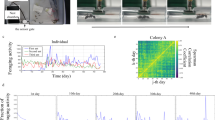Abstract
The purpose of this study is to clarify the interaction between the formation mechanism of the distribution pattern of ants supported by pheromone signals and the regulation mechanism of task-allocation in collective behavior of an ant colony. In this paper I design two types of ant colony model focusing on pheromone signals and the sensitivity of ants, and analyze simulated behaviors of the models. First, I design three foraging models (trail, attraction and desensitization models) composed by ants with different sensitivities to recruit pheromone. Among them, the desensitization model composed for ants that change their sensitivities in response to environmental information around them always shows the best foraging efficiency, stable recruitment pattern and balanced allocation among subtasks. In the second, I design a task-allocation model composed for ants carrying out foraging and mound-piling tasks using independent signals for each task. The results indicate that weak interference occurs between both tasks.
Access this chapter
Tax calculation will be finalised at checkout
Purchases are for personal use only
Preview
Unable to display preview. Download preview PDF.
Similar content being viewed by others
References
Hoelldobler B. and Wilson E. O. (1990) “The Ants”, The Belknap Press
Gordon D. M. (1999) “Ant at work”, Free Press
Pereira H. M. and Gordon D. M. (2001) “A trade-off in task allocation between sensitivity to the environment and Response time”, J. Theor. Biol. 208:265–184
Deneubourg J.-L. et al. (1983) “Probabilistic Behavior in Ants; A Strategy of Errors?”, J. Theor. Biol. 105:259–271
Camazine S. et al. (2001) “Self-organization in biological system”, Princeton University Press
Nakamura M. and Kurumatani K. (1997) “Formation mechanism of pheromone pattern and control of foraging behavior of an ant colony”, In: Langton C. G. et al. (eds) Artificial Life V, The MIT Press, pp 64–77
Nakamura M. and Kurumatani K. (1997) “Optimization of foraging behavior in an ant colony model (in Japanese)”, Proceedings of 9th SICE Decentralized Autonomous System Symposium, pp 271–276
Stephens D. W. and Krebs J. R. (1986) “Foraging theory”, Princeton University Press
Author information
Authors and Affiliations
Editor information
Editors and Affiliations
Rights and permissions
Copyright information
© 2005 Springer-Verlag Berlin Heidelberg
About this paper
Cite this paper
Nakamura, M. (2005). Regulation Mechanism of Task-allocation and Formation Mechanism of Ants’ Distribution Pattern in Collective Behavior of Ant Colony Models. In: Abraham, A., Dote, Y., Furuhashi, T., Köppen, M., Ohuchi, A., Ohsawa, Y. (eds) Soft Computing as Transdisciplinary Science and Technology. Advances in Soft Computing, vol 29. Springer, Berlin, Heidelberg. https://doi.org/10.1007/3-540-32391-0_97
Download citation
DOI: https://doi.org/10.1007/3-540-32391-0_97
Publisher Name: Springer, Berlin, Heidelberg
Print ISBN: 978-3-540-25055-5
Online ISBN: 978-3-540-32391-4
eBook Packages: EngineeringEngineering (R0)




